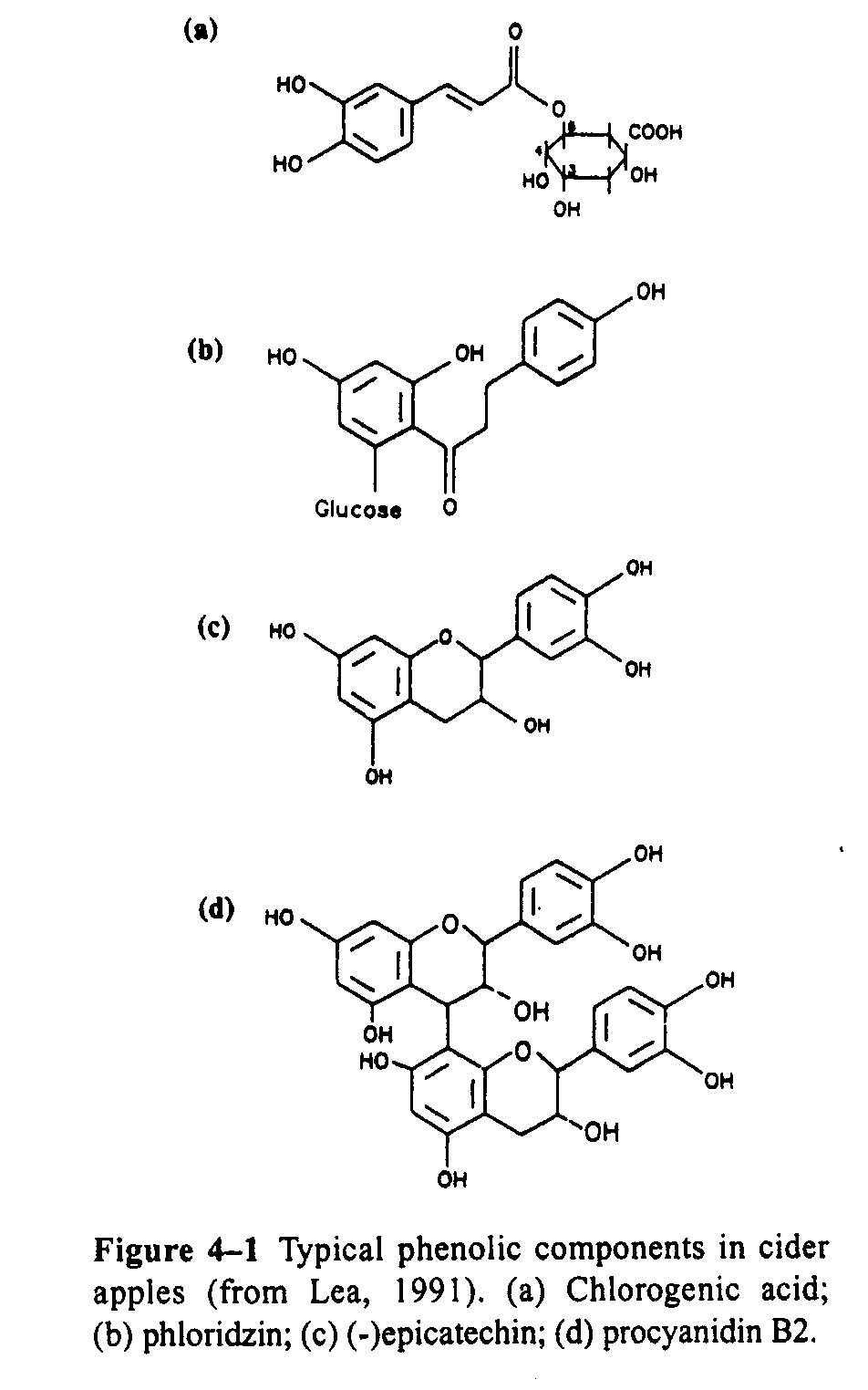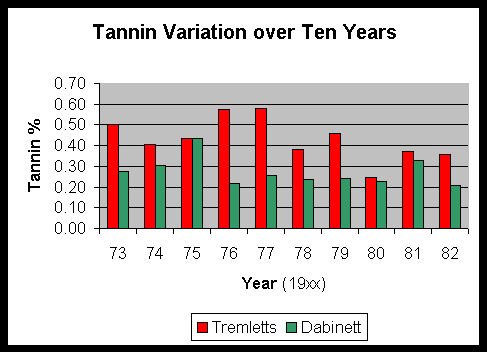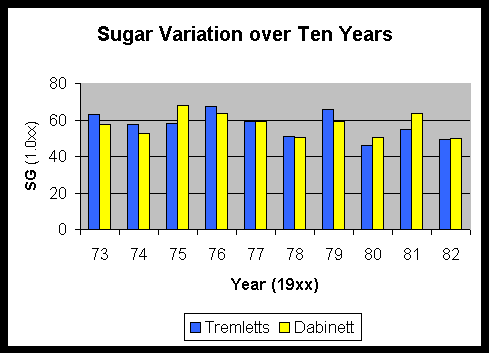
Tannin is rightly regarded as the most distinctive feature of many
cider apples. It is also a subject covered by much confusion. This little
essay tries to briefly answer the questions :
What is tannin?
Tannin is a loose term for a whole collection of non-volatile phenolic substances found in apples, grapes and many other fruits, and which provide 'body' to fermented beverages. There are a dozen or more of these in apples, such as chlorogenic acid, phloridzin, epicatechin and the procyanidins. Only the procyanidins are 'true tannins' in the sense of being able to tan protein (e.g.animal hides) or to produce an astringent sensation in the mouth. However, in this short essay I shall break with the habits of a professional lifetime and use the term 'tannin' in its loosest sense to cover all apple phenolics except where otherwise indicated! By and large the content of 'true tannin' in most apples is about half the level of 'total phenolics'. But the level of 'true tannin' parallels the level of 'total phenolics' in most apples pretty closely. Bittersweet apples have the most tannins or phenolics, and dessert apples the least.

I have no intention here of talking about tannin chemistry and function.
You can find external references to this elsewhere
on the website. There is also a downloadable PDF presentation
I gave on the topic which you might find useful if you want more
detail. Of the four chemical structures given here, only the last
one (procyanidin B2) is a 'true tannin'. But all of them respond
to the analytical methods described below.
How and why does tannin vary?
Tannins are what are known in plant biochemistry as 'secondary metabolites'. They have defensive and protective functions in the plant and so, unlike the primary metabolites such as sugars, the extent of their synthesis depends very largely on environmental and genetic factors. Hence bittersweet apples always contain more tannin than sweet (dessert) apples, and apples grown under low nitrogen regimes or adverse weather conditions tend to have more tannin too.
Data which I obtained in the 1970's, growing Dabinett trees in pots,
shows the effect of fertiliser regime quite clearly.
Tannin
is increased (though at the expense of overall yield) if nutrients are
restricted. Juice nitrogen levels also fall and fermentation rate
diminishes - these factors may have other implications for cider quality
too.
[The phenolics of ciders: effect
of cultural conditions.
Lea, A. G. H.; Beech, F. W.
Journal of the Science of Food and Agriculture 1978, 29 (5) 493-496]
Comparison of pot-grown 'fed' and 'unfed' Dabinett trees and fruit
|
|
|
|
| Leaf colour |
|
|
| Fruit Colour |
|
|
| Leaf N (%) |
|
|
| Leaf K (%) |
|
|
| Crop weight (lbs) |
|
|
| Juice SG |
|
|
| Juice acidity (% as malic) |
|
|
| Juice pH |
|
|
| Juice nitrogen (mg per 100ml) |
|
|
| Days of fermentation (inoculated yeast AWY 350R) |
|
|
| Tannin (Lowenthal permanganate titration %) |
|
|
| Perceived cider astringency (trained sensory panel at p = 0.1) |
|
|
| Perceived cider bitterness (trained sensory panel at p = 0.05) |
|
|
The variables seen to change most between high and low nutrient input are highlighted in yellow.
Tannin variation in the orchard
It proved to be much more difficult to show these effects in the orchard, although by statistical techniques it is possible to demonstrate that the same relationships hold good. However, the effect of weather and other field conditions have a major influence on tannin on a year to year basis.

Some unpublished data of mine from a set of field trials at Monnington-on-Wye
in Herefordshire, where the fruit from the same individual trees under
the same fertiliser regime was analysed yearly for 10 years, shows the
extent of this annual variation. The tannin CV* is around 25%, which means
in practice that tannin values from the same tree may vary +/- 50% around
the average value over successive years. The average tannin values over
the ten year period were 0.43% for Tremletts and 0.27% for Dabinett.

Note by comparison that the SG values are much more consistent than the tannin. The CV* for SG is about 10%, which means that the sugar content will vary only about +/- 20% around the average value over successive years. The average SG over the 10 year period was 1.057 for both cultivars.
* - The CV is a statistical measure of scatter called the 'coefficient
of variation', and is obtained by dividing the 'standard deviation' by
the mean or average value. The smaller the CV, the less variation
there is in the data. Roughly speaking, 95% of all measured values will
fall within a band of twice the standard deviation above and below the
mean (or twice the percentage value of the mean which is represented by
the CV).
How do we measure tannin?
Since tannin is an assemblage of many different things, not just one chemical entity, there are many different ways of measuring it and each method may give different results. So it is important to state the method used when quoting tannin data.
There are two main methods in use for ciders and wines. One of these is the Lowenthal permanganate titration, which dates from 1877 and was the method used at the Long Ashton Research Station from 1903 until its closure in the 1980's. This expresses the tannin in arbitrary percentage units (originally of purified 'tannic acid' which is a polygalloyl glucose obtained from oak galls). The other method is the Folin-Ciocalteau colorimetric assay which dates originally from 1912 but in its present routine form owes much to Emeritus Professor Vernon Singleton of the University of California at Davis. In this form it is commonly used in the wine industry worldwide, and the tannin is expressed in terms of 'total phenolics as gallic acid equivalents (GAE)'.
Both methods are generally used directly to give values for total 'tannin'. Both can also be used indirectly, after precipitation of the true tannins by chemical means (e.g. reaction with gelatin or formaldehyde), to give 'true tannin' by difference. This refinement is more tedious to do and for routine purposes is not generally necessary. The figures given here are all obtained by the direct method for total phenolics or total tannin.
There are generally no significant differences between juice and fermented
cider in the tannin figures obtained by any one method. Although tannin
is subject to oxidation and loss if the apple pulp is greatly exposed to
air between milling and pressing, the practical losses between fruit extracted
with no oxidation (sulphite during milling) and with normal oxidation during
handling amount to no more than around 20% (reference)
Comparison of methods
The table below shows data I obtained on a set of single variety ciders
mostly from my own orchard (2001) which were prepared and fermented under
standard conditions with added yeast (Uvaferm BC). Both sample sets
were analysed on the same day in December 2002 by the Lowenthal and the
Folin procedures.
Comparison of Cider 'Tannin' assayed by Lowenthal and Folin Methods
|
|
|
|
| Harry Masters Jersey |
|
|
| Mixed Bittersweet (Suffolk) |
|
|
| Michelin (Somerset) |
|
|
| Kingston Black |
|
|
| Stoke Red |
|
|
| Dabinett |
|
|
| Yarlington |
|
|
1 - expressed as % arbitrary tannic acid units (see method)
2 - expressed as % gallic acid equivalents (see method)
Note especially the following: